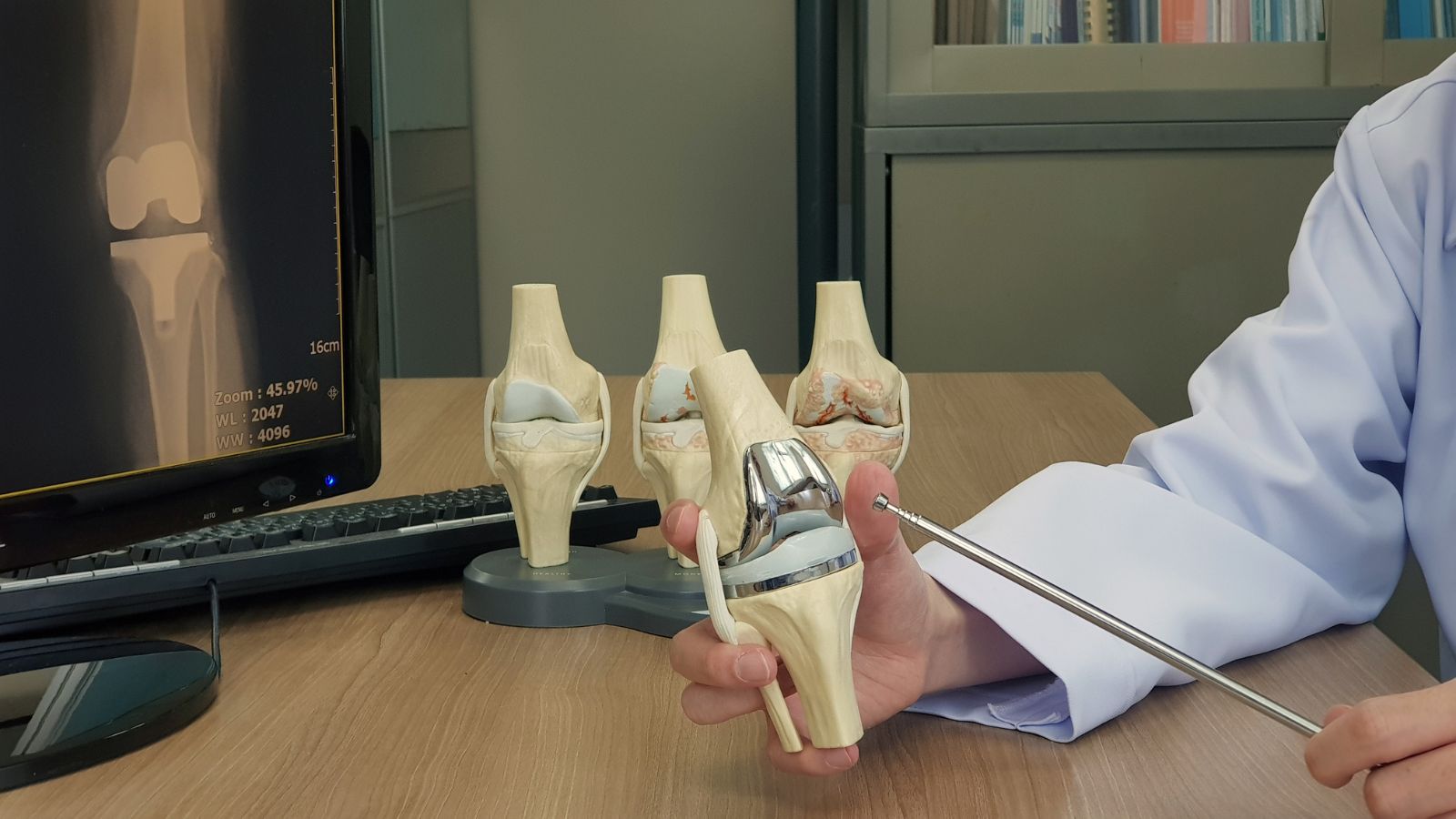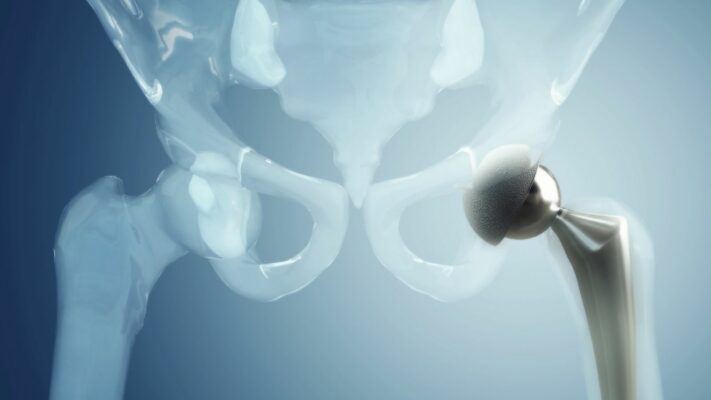Prof. Dr. Murat Demirel, one of the best orthopedic doctors performing knee replacement surgery in Ankara, stands out with his long-standing experience in treating advanced knee osteoarthritis, cartilage wear, or irreversible joint surface damage. Knee replacement surgery is a modern surgical method that aims to relieve pain, improve joint mobility, and enhance quality of life by replacing damaged joint surfaces with artificial prostheses. Prof. Dr. Demirel performs personalized surgical plans for each patient in hospitals with advanced medical equipment and high hygiene standards among those performing knee replacement surgery in Ankara.
By conducting a detailed preoperative evaluation, Prof. Dr. Demirel determines the most suitable type of prosthesis and surgical technique and closely follows up his patients after the surgery. With his postoperative recommendations, the recovery process after knee replacement surgery becomes fast, safe, and permanent. He also provides transparent and up-to-date information about knee replacement surgery costs in Ankara, helping patients make informed decisions. You can contact us to book an appointment and restore your knee health, reduce your pain, and regain your freedom of movement.
| Surgery Name | Total Knee Replacement (Total Knee Arthroplasty) |
| Application Area | Knee joint (femur, tibia, patella joint surfaces) |
| Indications | Advanced knee osteoarthritis (gonarthrosis), rheumatoid arthritis, post-traumatic arthritis |
| Surgical Method | Open surgery; damaged joint surfaces are removed and replaced with metal and polyethylene prostheses |
| Type of Anesthesia | Spinal, epidural, or general anesthesia |
| Operation Duration | Approximately 1.5–2 hours |
| Hospital Stay | Usually 3–5 days |
| Recovery Process | 3–6 months; should be supported with physical therapy |
| Complications | Infection, blood clot, prosthesis loosening, nerve-vessel injuries, stiffness |
| Advantages | Pain reduction, increased mobility, improved quality of life |
| Alternative Methods | Conservative treatment, high tibial osteotomy, partial knee replacement |
| Ideal Patient Profile | Individuals with advanced osteoarthritis, pain affecting quality of life, and no response to conservative treatments |
Yazı İçeriği
What is Knee Replacement Surgery?
Knee replacement surgery can be compared to retreading an old, worn-out car tire. Instead of discarding the entire tire, we only replace the worn outer surface that touches the ground with a new one. Knee replacement surgery works on a similar principle; not the entire knee, but only the damaged cartilage and the thin underlying bone surfaces are removed. In medical terms, this procedure is called “knee arthroplasty.”
During this surgery, the contact surfaces of the three main bones forming your knee joint – the femur (thighbone), tibia (shinbone), and patella (kneecap) – are covered with specially designed biocompatible (body-compatible) metal and polyethylene (a durable type of plastic) components.
Femoral Component: A shiny, smooth metal covering is placed on the lower end of your femur, mimicking the natural curve of the bone.
Tibial Component: On the upper surface of your tibia, a metal base plate is placed, topped with a durable polyethylene insert that acts as a cushion.
Polyethylene Insert: Between these two metal surfaces, a smooth polyethylene disk is inserted, eliminating friction and absorbing shock, functioning like your original cartilage. This allows your new joint to move smoothly and comfortably.
Patellar Component: When necessary, the back surface of your kneecap may also be covered with a small, dome-shaped polyethylene piece. This is also referred to as a patellar prosthesis.
The most important advantage of this procedure is that most of the healthy ligaments, tendons, and muscles in your knee are preserved. The surgeon carefully protects and rebalances these structures, ensuring that your new joint is both stable and capable of natural movement. In other words, the surgery does not create a new knee from scratch but restores and strengthens your existing structure to regain its function.
When is Knee Replacement Surgery Necessary?
Many people live with knee pain, but not every case of knee pain requires knee replacement surgery. Knee replacement is usually considered when all other treatment options have been tried and the patient’s quality of life has significantly declined. If you are experiencing one or more of the following conditions, knee replacement surgery may be a solution for you:
- If you suffer from severe pain even during the simplest daily activities (such as walking, climbing stairs, or standing up from a chair).
- If you have persistent knee pain that wakes you at night or prevents you from falling asleep.
- If you still experience pain despite using supportive devices such as a cane or walker.
- If there is a visible deformity in your knee (bowing inward or outward).
- If non-surgical methods such as medications, physical therapy, weight loss, and intra-articular injections no longer relieve your pain.
- If your knee problems prevent you from socializing, pursuing hobbies, or spending time with loved ones.
The most common medical conditions leading to knee replacement are:
- Osteoarthritis (Degenerative Joint Disease)
- Rheumatoid Arthritis (Inflammatory Arthritis)
- Post-traumatic Arthritis (Arthritis developing after injury or accident)
- Avascular Necrosis (Loss of blood supply leading to bone death)
Remember, the decision to undergo knee replacement surgery is not made overnight. It is a decision jointly made by the patient and doctor after evaluating the patient’s symptoms, expectations, and radiological findings together.
Who is the Ideal Candidate for Knee Replacement Surgery?
The success of knee replacement surgery depends not only on surgical technique but also on proper patient selection. The definition of an “ideal candidate” includes not only medical criteria but also the patient’s expectations, lifestyle, and willingness to participate in the postoperative process.
In general, a suitable candidate for surgery has the following characteristics:
- Has not benefited from non-surgical treatments.
- Experiences pain and mobility limitations that significantly reduce quality of life.
- Has the cognitive capacity to understand the benefits and potential risks of surgery.
- Is motivated and willing to participate in the long and demanding physical therapy process required after surgery.
- Has a general health condition strong enough to tolerate anesthesia and surgery.
Although age alone is not a determining factor, prostheses have a certain lifespan, so all alternative treatments are usually considered in very young patients. However, thanks to modern prostheses and techniques, this surgery is also successfully performed in active patients in their 40s and 50s.
There are, however, some conditions that may make knee replacement surgery unsuitable or increase risks. Situations that may require postponement or contraindicate surgery include:
- Presence of an active knee infection.
- Active, uncontrolled infections in other parts of the body (such as dental or urinary tract infections).
- Severe insufficiency of the extensor mechanism (muscle system responsible for knee extension).
- Uncontrolled chronic conditions (such as advanced heart failure or uncontrolled diabetes).
- Severe vascular obstruction.
- Morbid obesity (Body Mass Index > 40), which significantly increases the risk of complications – weight loss before surgery is strongly recommended.
What Types of Knee Prostheses Exist?
Not every patient’s knee damage is the same. In some cases, damage spreads throughout the entire joint, while in others, it is limited to just one area. Therefore, different prosthesis designs are available for different needs. Your surgeon will choose the most appropriate type of prosthesis based on the location and extent of the damage.
Total Knee Replacement (TKR): This is the most commonly performed type of knee replacement. It is preferred when arthritis affects all three compartments of the knee – the inner, outer, and under the kneecap. As the name suggests, all surfaces of the joint are renewed.
Partial (Unicompartmental) Knee Replacement (UKA): If arthritis is confined to just one part of the knee (usually the inner side), this prosthesis may be an excellent option. In this method, the healthy cartilage, bone, and ligaments of the knee are preserved. Since it is performed through a smaller incision, recovery is usually quicker, and patients often feel their knee is more “natural.” However, not all patients are suitable for this procedure.
Patellofemoral Knee Replacement: This is a type of partial replacement used when damage is limited to the joint between the kneecap (patella) and the thigh bone (femur). It can be particularly effective for certain patients suffering from anterior knee pain.
Revision Knee Replacement: This is used when a previously implanted prosthesis fails due to loosening, wear, or infection. The old prosthesis is removed and replaced with a new one. This procedure is more complex than the first surgery.
How is the Preparation Process for Knee Replacement Surgery?
A successful knee replacement begins long before the actual surgery day. A thorough preparation process not only increases the safety of the operation but also ensures a smoother and more comfortable recovery. Preparation usually includes physical, medical, and environmental adjustments.
Medical Evaluation:
Once the decision for surgery has been made, a series of tests and assessments are conducted to determine if your general health is suitable for such a major operation:
- Comprehensive blood tests
- Urine analysis
- Chest X-ray
- Electrocardiogram (ECG)
- Consultations from cardiology or other specialties if needed
- Anesthesia evaluation by an anesthesiologist
Additionally, to minimize the risk of postoperative infections, it is very important to treat any potential infection sources in your body (such as decayed teeth or gum disease) before surgery.
Physical Preparation:
The stronger you are before surgery, the faster your recovery will be. Your surgeon or a physiotherapist may recommend certain exercises to perform before the operation. These “pre-rehabilitation” exercises aim to strengthen your leg muscles, maintain joint mobility, and prepare you for postoperative exercises. If you smoke, quitting at least a few weeks before surgery is crucial for wound healing and lung health.
Preparing the Home Environment:
It is wise to make certain adjustments in your home to make life easier once you return after surgery. Completing these preparations beforehand will make your recovery safer and more comfortable:
- Remove small rugs, mats, and floor cables that could cause tripping and falling.
- Rearrange furniture to create wider pathways for moving around with a walker or crutches.
- Install grab bars in the bathroom and use a shower chair or stool.
- Consider a raised toilet seat to make sitting and standing easier.
- Keep frequently used items (phone, remote control, books, water) within easy reach.
- Ensure stair railings are sturdy if you need to use stairs.
- Arrange for a family member or friend to assist you during the first few weeks.
What is the Recovery Process After Knee Replacement Surgery?
Recovery after knee replacement is a marathon, not a sprint. It requires patience, determination, and active participation, and it usually consists of several stages.
First Days in the Hospital:
- After surgery, you typically stay in the hospital for 1 to 3 days. This duration may vary depending on the type of anesthesia used, the surgery performed, and your overall health condition.
- Immediately after surgery, ice packs are applied to reduce swelling, and simple ankle exercises are encouraged to prevent blood clots.
- Usually on the evening of the surgery or the following morning, you are helped to stand up with a physiotherapist and take your first steps using a walker. Early movement is the key to recovery.
- Your pain is managed with effective intravenous or oral painkillers. The goal is not to completely eliminate pain but to reduce it to a comfortable level that allows you to exercise.
- Before being discharged, you will learn how to move safely in bed, how to sit and walk properly, and how to perform basic exercises.
Returning Home and the First Weeks (0–6 Weeks):
This period is the most intensive phase of recovery and requires the most attention.
Pain and Swelling Control: Swelling and bruising around your knee are normal. Applying ice packs for 15–20 minutes several times a day and keeping your leg elevated above heart level while resting are very effective in reducing swelling.
Wound Care: It is important to keep your surgical wound clean and dry. Follow your doctor’s instructions carefully regarding dressing changes and bathing.
Physical Therapy: The most crucial part of this stage is physical therapy. A physiotherapist may visit your home, or you may go to a rehabilitation center. Exercises focus on regaining knee motion (bending and straightening) and strengthening your muscles. Adhering to your prescribed exercise program is critical for long-term success.
Walking: For the first few weeks, you will need a walker or crutches. As your balance and strength improve, you may transition to a cane and eventually walk independently.
Progress in Recovery (6 Weeks – 3 Months):
- During this period, you gradually return to daily activities.
- Pain and swelling significantly decrease.
- Most patients can start driving again (with doctor’s approval).
- You can walk longer distances and climb stairs with more ease.
- This is an excellent time to begin low-impact exercises such as swimming and stationary cycling.
Full Recovery (3 Months and Beyond):
Complete recovery and full adaptation to your new knee may take 6 months to 1 year. During this period, your muscle strength and endurance will continue to improve. You can return to a more active lifestyle, but it is important to follow activity restrictions to protect the longevity of your prosthesis.
Which Activities Are Safe After Knee Replacement?
Your new knee is designed to provide you with a pain-free life, but protecting it is your responsibility. The goal is to remain active, but wisely active.
Safe and Enjoyable Activities:
- Walking
- Swimming
- Stationary or regular cycling (on flat terrain)
- Golf
- Low-impact dancing
- Bowling
- Elliptical trainer
- Doubles tennis
Activities to Avoid or Approach with Caution:
These activities may place excessive stress on your prosthesis, leading to premature wear or loosening.
- Running and jogging
- Sports that require jumping (basketball, volleyball)
- Singles tennis
- Soccer
- Advanced-level skiing
- Martial arts
Remember, every patient is different. Always consult your doctor before starting any new sport or activity.
What Do Modern Knee Replacement Technologies Offer?
Knee replacement surgery technology is constantly evolving. Modern techniques allow surgeries to be performed with greater precision, ensure better prosthesis placement, and potentially enable faster recovery.
Robotic-Assisted Knee Replacement Surgery: In this technology, the surgeon performs the procedure with the help of a robotic arm. A three-dimensional model of your knee is created using preoperative CT scans. The surgeon meticulously plans the surgery on this model. During the operation, the robotic arm helps the surgeon make bone cuts with millimetric accuracy and place the prosthesis in the ideal position. The robot does not replace the surgeon; it enhances the surgeon’s expertise and skill with technological precision.
Computer-Assisted (Navigation) Surgery: This functions like an intelligent “GPS” system during the procedure. Using small sensors placed on the patient’s leg and infrared cameras, the exact real-time position of the bones and surgical instruments is displayed on a computer screen. This guides the surgeon in achieving perfect alignment of the prosthesis.
Patient-Specific Knee Prostheses: Instead of standard-sized prostheses, customized implants designed specifically for the patient’s anatomy can be used. MRI or CT scans taken before surgery allow the creation of prostheses and cutting guides that fit the knee like “tailor-made clothing.” The goal is to create a more natural joint feeling and minimize bone loss.
Each of these technologies has its own advantages and is suitable for specific patient profiles. Your surgeon will guide you in deciding which method is most appropriate for you.
What Are the Possible Risks of Knee Replacement Surgery?
Like any major surgical procedure, knee replacement surgery carries some potential risks. Thanks to modern surgical techniques, anesthesia methods, and postoperative care protocols, these risks are quite low. However, it is important to be aware of them as an informed patient. Your surgical team will take every possible precaution to minimize them.
The most common potential risks include:
- Infection: Both superficial wound infection and deep joint infection around the prosthesis.
- Blood Clot (Thrombosis): Formation of clots in the leg veins and, in rare cases, migration of these clots to the lungs (pulmonary embolism).
- Prosthesis Loosening or Wear: Over time, prosthetic components may wear out or loosen from the bone.
- Joint Stiffness: Inability to bend or straighten the knee adequately after surgery.
- Nerve or Vessel Injury: Damage to blood vessels or nerves near the surgical site (very rare).
- Persistent Pain: A small percentage of patients may continue to experience pain despite a technically successful surgery.
Anesthesia-Related Risks.
- There are comprehensive measures in place for each of these risks. For example, antibiotics are administered before and after surgery to prevent infection; blood thinners, compression stockings, and early mobilization help reduce clotting risks. The best way to prevent joint stiffness is active participation in physical therapy.
Frequently Asked Questions
What is knee replacement surgery and which patients is it performed on?
Knee replacement surgery is a procedure in which damaged joint surfaces are replaced with an artificial joint in patients whose knee function is severely impaired due to advanced osteoarthritis, joint damage, or persistent pain. It is generally performed on patients who do not respond to medication, physical therapy, or other treatments.
How is knee replacement surgery performed?
The surgery is performed under general or spinal anesthesia using special surgical instruments. The knee joint is opened, damaged bone and cartilage tissues are removed, and appropriately sized metal and plastic prosthetic components are implanted. The procedure usually takes 1–2 hours.
What is the recovery process like after surgery?
After surgery, patients are usually mobilized on the same day or the following day. The average hospital stay is 3–5 days. With physiotherapy and exercises, knee mobility and muscle strength improve rapidly within the first few weeks. Full recovery typically takes 6–12 weeks.
Is knee replacement surgery risky?
As with any surgical procedure, there are potential risks such as infection, vascular or nerve injury, blood clots, and prosthesis loosening. However, with modern surgical techniques and sterilization, these risks are quite low.
How long does a knee prosthesis last?
Modern knee prostheses generally last 15–20 years. The lifespan of the prosthesis depends on factors such as the patient’s age, weight, activity level, and postoperative care.
What should be considered after knee replacement surgery?
During the recovery period, wound care, prescribed exercises, and regular use of medications are very important. Excessive stress on the knee, falling from heights, and sudden twisting movements should be avoided.
Is there pain after knee replacement surgery?
Mild to moderate pain in the first days after surgery is normal and usually well controlled with pain medication. Pain generally decreases and disappears over time.
Who is not recommended for knee replacement surgery?
It is not recommended for patients with severe infections, active vascular disease, or chronic illnesses that may prevent healing, as well as for individuals who are extremely overweight or whose bone structure is unsuitable.
Is knee replacement surgery performed in state hospitals?
In Turkey, knee replacement surgery is performed in both state and private hospitals. In state hospitals, most of the surgery cost is covered by SGK, while pricing in private hospitals may vary.
Is it possible to return to sports and social life after knee replacement?
With successful surgery and rehabilitation, patients can usually walk without pain, return to daily activities, and participate in light sports. However, heavy sports and activities that strain the joint are not recommended after knee replacement.




